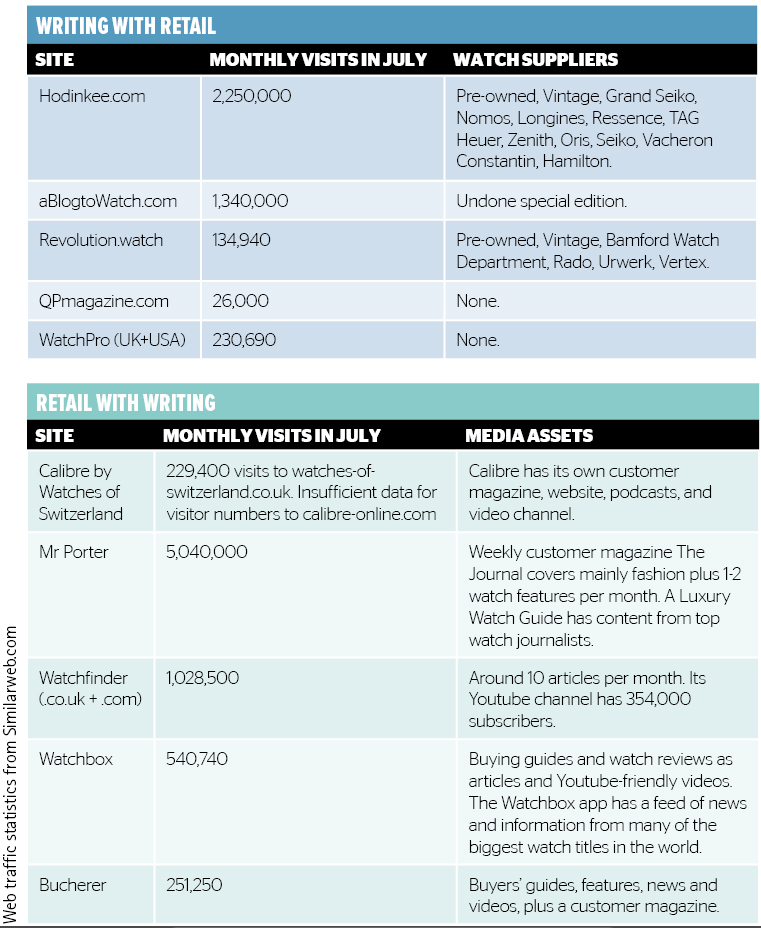If you think the retail landscape is changing fast with the internet affecting everything, try being a publisher. The simple days of producing glossy monthlies packed with luxury advertising are over as brands shift marketing money to digital platforms. Quality journalism is expensive, and the only way to pay for it today, some have concluded, is to start selling watches and accessories online. Tom Mulraney browses through the current offers and asks whether obvious conflicts of interest can be accommodated.
It’s no secret that traditional media businesses are in a state of flux. Shrinking circulation, increased competition and ever diminishing advertising budgets have many publishers scrambling to find alternative sources of revenue.
As a result, a popular trend has emerged. Something that I have termed “transactional publishing”. Traditional media companies that are increasingly behaving like retailers.
Spurred on by the success of e-commerce giants like Net-a-Porter and FarFetch, which use magazine-style content to attract and engage audiences, many publications are now trying to adopt similar models. With varying degrees of success.
The watch industry is by no means immune to this. A number of prominent watch publications have entered the realm of transactional publishing in recent times. Whether it’s proving to be a successful strategy or not is difficult to say. After all, as any retailer reading this will know, there’s a big difference between getting someone in your store, versus getting them to actually buy something. Likewise, it’s unclear the impact this is having on how readers perceive these publications. And their ongoing ability to provide impartial, unbiased thoughts and opinions on products they may or may not also be selling (or, just as importantly, products that are competitors to the ones they’re selling.)
So, what is transactional publishing and why has it risen to such prominence in recent years? You won’t find an official definition of this term anywhere, at least not as it relates to online retail. That’s because I made it up. Essentially, it’s a broad term I use to describe publishers who are attempting to generate sales directly as a result of the content they publish.
Now, you could make the argument that the role of publishers has always been to generate sales from the content they create. And to some degree I would agree with you. The difference being, traditionally they were generating these sales for someone else. There’s also the matter of informing and entertaining their audiences, but this is of secondary importance. At least in the eyes of the brands that partner and advertise with such publications.
Of course, publishers have not invented this “new” business model. In fact, you could argue that many have been very late to the party. Rather it is the growing global trend towards content marketing that has seen it flourish. It sounds like a hot new buzz word, but in reality, savvy entrepreneurs have been using this strategy to sell things for centuries. For example, Benjamin Franklin issued the Poor Richard’s Almanack to promote his printing business all the way back in 1732.
E-commerce businesses like Mr Porter (now owned by Richemont) and FarFetch have been built around a core strategy of positioning themselves as expert arbiters of taste and style. Recognising early on that shoppers are increasingly happy to take fashion advice from retailers, these businesses – and many others like them – developed in-house publishing divisions producing traditional glossy magazines, newspapers and supplements for their customers along with prodigious volumes of articles for distribution across websites and social media.
As Mr Porter managing director Toby Bateman explained in an interview with WatchPro last year, content is key to acquiring new customers to its watch business because it gets picked up across the web and social media. The difference of course is that these businesses started out life as e-commerce retailers. They may act like publishers in some ways, but they are very much built on a retail foundation, with the product and infrastructure to match.
Seeing the acceptance and success of this model, it’s only natural that publishers themselves are now attempting to close the loop. Meaning they are also selling (or at least offering for sale) some or all of the products they are writing about. As well as supposedly providing impartial reviews of the competing products they don’t sell. At this point, you might be thinking that surely this represents a not insignificant conflict of interest. Or at the very least challenges the concept of journalistic objectivity. And certainly, there is some validity to this concern. But at the same time, publishers’ heavy reliance on advertising dollars to stay afloat could also potentially be cast in the same light.
IN DEPTH: The making of Mr Porter according to managing director Toby Bateman
Arguably the standard setter for transactional publishing in the watch space is watch blog – turned media publication – turned authorized retailer, Hodinkee. Founded in 2008 in New York by Ben Clymer after he was made redundant during the financial recession, Hodinkee has grown to become the most read online watch publication in the world. According to web traffic analysis service Similarweb, Hodinkee averaged around 2.2 million visitors per month to its website over the last six months. The business now employs 35 staff and reported an unofficial turnover of $15 million last year. Starting with the sale of watch straps and accessories back in 2012, before later entering the vintage market, Hodinkee is now an authorized retailer for more than 10 brands.

Likewise, prominent watch magazine publisher Revolution announced its partnership with pre-owned seller WatchBox early last year. The idea being to sell pre-owned timepieces supplied by the e-commerce giant as well as separately, selling new limited-edition models by 10 brands, including Tag Heuer, IWC Schaffhausen and Hublot. At the time, Bruce Lee, Revolution’s co-owner, said in an interview. “WatchBox will make inventory available and we will provide the storytelling and videos. That’s why the marriage makes sense.”
At the time Dr. Lee said he expected watch revenues of as much as $60 million in the first year, with double-digit growth in subsequent years. This could be viewed as a somewhat bullish prediction given the more modest turnover of the aforementioned online watch media juggernaut, Hodinkee. Yet it does provide an indication of how optimistic publishers are about the potential of transactional publishing to change their faltering fortunes.
The flipside to all this though is an ever-intensifying fight to win viewer attention. Online-only businesses like Mr. Porter and Hodinkee (for now – the company is rumoured to be opening a physical retail space in New York this year) have already built a huge lead in this regard. For example, over the last 6 months roughly 10 times more people visited Hodinkee’s website each month than they did Bucherer’s.
Of course, Bucherer is a major retail group with a physical footprint spanning multiple countries, with annual revenues mutiples higher than Hodinkee’s. But the face of retail is changing, with more and more purchasing activity moving online. In order to stay relevant long-term, retailers need to find new ways to attract visitors to their websites.
Not surprisingly then retailers are increasingly looking to incorporate content into their marketing strategies, bringing themselves into direct competition with publishers. Ironically, many of these retailers use the same journalists and content producers formally in the employ of the very publishers they are now competing with.
Changes in the publishing industry mean these talented individuals now work on a freelance basis, giving them the flexibility and freedom to accept a broader range of commissions. As a result, the quality of the content produced by retailers like Watches of Switzerland and ROX, is first rate. Of course, creating an engaging experience online and driving high volumes of traffic requires more than just great content. As retailers are fast discovering, there’s a whole ecosystem to be understood and implemented.
A sometimes overlooked but major benefactor of this new reality is the brands themselves. It’s impossible to estimate how much free publicity is being generated thanks to so many different outlets clamouring to write favourable things about their products or “tell their stories”.
Of course, quality can and does vary, something which the brands have no control over and which I’m sure causes consternation from time to time. Yet, it seems a small price to pay. And indeed, as search engine algorithms and content marketers get ever more sophisticated, only the best content is likely to rise to the top to be consumed by the masses. It does put added pressure on brand to constantly supply content producers with something to write about though. Possibly contributing to some of the questionable partnerships and collaborations we’ve seen in recent years.
Ultimately, the real winners it seems though are the end consumer. At their fingertips they now have access to high-quality and insightful content on any number of watch-related topics from any number of sources. Regardless of whether they’re in the market to buy or not. And best of all, just about all of it is free to consume. Whether it can be viewed as independent and impartial content, however, is another matter entirely. But maybe that’s just the way of the world now? Maybe the concept of traditional media being separate from retail is well and truly dead. The lines between the two blurred beyond recognition.
If that is indeed the case, it will be interesting to see how consumers feel about it in five-years, when they’ve grown weary of looking for content that is simply trying to educate and entertain. Not sell them something.
 About the author: Tom Mulraney is a 10-year veteran of the watch industry. He is the publisher and editor of The Watch Lounge, a digital magazine with a unique take on the world of luxury watches. www.thewatchlounge.com
About the author: Tom Mulraney is a 10-year veteran of the watch industry. He is the publisher and editor of The Watch Lounge, a digital magazine with a unique take on the world of luxury watches. www.thewatchlounge.com


